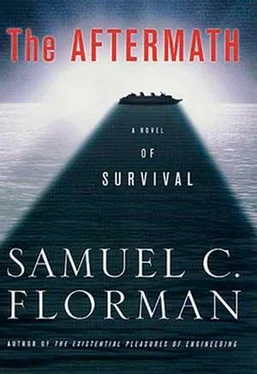Samuel Florman - The Aftermath
Здесь есть возможность читать онлайн «Samuel Florman - The Aftermath» весь текст электронной книги совершенно бесплатно (целиком полную версию без сокращений). В некоторых случаях можно слушать аудио, скачать через торрент в формате fb2 и присутствует краткое содержание. Город: New York, Год выпуска: 2001, ISBN: 2001, Издательство: Thomas Dunne books, Жанр: sf_postapocalyptic, на английском языке. Описание произведения, (предисловие) а так же отзывы посетителей доступны на портале библиотеки ЛибКат.
- Название:The Aftermath
- Автор:
- Издательство:Thomas Dunne books
- Жанр:
- Год:2001
- Город:New York
- ISBN:0-312-26652-9
- Рейтинг книги:5 / 5. Голосов: 1
-
Избранное:Добавить в избранное
- Отзывы:
-
Ваша оценка:
- 100
- 1
- 2
- 3
- 4
- 5
The Aftermath: краткое содержание, описание и аннотация
Предлагаем к чтению аннотацию, описание, краткое содержание или предисловие (зависит от того, что написал сам автор книги «The Aftermath»). Если вы не нашли необходимую информацию о книге — напишите в комментариях, мы постараемся отыскать её.
The Aftermath — читать онлайн бесплатно полную книгу (весь текст) целиком
Ниже представлен текст книги, разбитый по страницам. Система сохранения места последней прочитанной страницы, позволяет с удобством читать онлайн бесплатно книгу «The Aftermath», без необходимости каждый раз заново искать на чём Вы остановились. Поставьте закладку, и сможете в любой момент перейти на страницу, на которой закончили чтение.
Интервал:
Закладка:
“But setting aside the extremes on either end, I think there is no reason we cannot expect to duplicate the experience of Kenya and Iran in the 1980s. After all, our population is relatively young and generally healthy. In South Africa, before the Event, almost half the population was under twenty-one years of age. After the rigors of fire and flood, I would guess that the average is even lower. The Engineering Village people are also young, on average—thanks mainly to my father’s policies in arranging the seminar, along with the hiring practices of cruise ship companies. And so far, we’re all amazingly healthy.
“If we lead an industrious, temperate life,” I went on, trying to add a jovial touch, “and marry early, like those colonists in Connecticut—and if we enjoy the Divine Benediction—the 4.1 percent figure should be achieved.” Then I sketched out the growth pattern, roughly, thus:
Projected Population
Today 27,500
In 18 years 55,000
In 36 years 110,000
In 54 years 220,000
In 72 years 440,000
In 90 years 880,000
In 108 years 1,760,000
I stopped to let them absorb these numbers, and then continued.
“If—to follow through on the captain’s concern—it would take a million people to establish and maintain an industrial society, then we can expect to reach that magic number in about ninety-four years. That’s a long time, to be sure; but no longer than it took our ancestors to build some of the medieval cathedrals. Even if none of us expects to live another century, we shouldn’t be afraid to start on a few long-term projects of our own. Our great-grandchildren will thank us.”
So far, my audience was as attentive as I could have hoped. But I hadn’t yet gotten to my main point, which was that we shouldn’t underestimate what can be achieved by our present population, right now and in the near-term future.
“Remember,” I continued, “at the time of the American Revolution, Boston contained no more than twenty thousand people and New York City between twenty-five and thirty thousand. The states of Rhode Island and New Jersey each had populations of only sixty thousand persons, while mighty New York and industrious Connecticut were barely at the two hundred thousand level. If we then consider what was achieved in the years immediately following the Revolution—Fulton’s steamboat in 1807; dozens of textile mills along New England’s rivers by the 1820s; the Baltimore & Ohio Railroad chartered in 1827—well, we should be bursting with optimism.
“Also, we tend to forget that the early American factories turned out substantial quantities of manufactured goods with surprisingly small numbers of workers. The blast furnaces of prerevolutionary days were run by about a dozen men. The average cotton factory employed thirty-five people, a paper mill fifteen, a flour mill only three. In 1807, a sizable shop in the Pennsylvania countryside manufactured steam engines and a variety of mechanical devices for many different industries, while employing on average no more than thirty-five workmen.”
I was now ready for the piece de resistance.
“In the mid-1800s, the Norris Locomotive Works of Philadelphia built locomotives, each of which contained some five thousand separate parts, each part designed, then cast or forged or pressed on site”—now it was Dr. Wilson Hardy, Sr., my dear old dad, who was glaring at me, so I hastily summarized—“sixty-four of these monsters were manufactured in a year with a workforce of only six hundred. Imagine: sixty-four locomotives built from scratch in a year by six hundred men!”
“Thanks, Wil,” my father said firmly, but with a slight smile to indicate that he was pleased I had done my homework and learned so much interesting history. Yet I could tell that I had said more than enough to make my point.
Captain Nordstrom most kindly wrapped up my remarks with a concession: “I guess that young Wilson here—a chip off the old block—has mustered enough facts to shoot me out of the water. So, if we need not be discouraged by the size of our population, let us go on to other matters.”
Later that night, I told Sarah about my brave entry into the great debate and described what I considered my creditable showing. She grew pensive.
Finally, very quietly, she said, “If your predictions about population growth are going to prove accurate, we will have to do our share, won’t we?”
My response, half in yearning and half in panic, was, “Of course, but shouldn’t we see the general situation organized a little better before we rush ahead with our own plans?”
Sarah had the final word on the subject: “Balzac said it was easier to be a lover than a husband, and I guess he was right.”
I assumed she was smiling, but in the darkness it was impossible to tell.
9
On the second day set aside for feedback sessions, the electrical engineers took a turn at venting their displeasure. “Uh-oh,” Herb Green quipped under his breath to Wil Hardy, “it’s the ‘Charge of the Electric Light Brigade.’ “
The leader of the onslaught was Donald Ruffin, president of the Institute of Electrical and Electronics Engineers. He was the inscrutable fiber-optics specialist who had said he didn’t know what to expect in Africa other than a bunch of angry elephants. On this occasion, he skipped the sarcasm and got right to the point.
“What we want to know, Wilson,” he said, poking a finger at Dr. Hardy, “is how you civil engineers have managed to take over this operation. Yesterday, my good friend John Hertzler raised some valid questions about centralized planning; but he didn’t get to the problem that our group thinks is most serious. You, along with your sidekick Alf Richards, want to keep us busy with bricks and concrete and then slowly, deliberately, reenact the Industrial Revolution.”
Ruffin pulled a piece of paper from his shirt pocket, referred to some scribbled notes, and continued in stentorian voice: “I haven’t heard a blessed word about solar energy, wind turbines, or atomic power, not to mention nuclear fusion. You’re going to busy us with digging in coal mines when we should be thinking about new so lutions for a new age. Why aren’t you planning to make photovoltaic cells, which could be used to recharge our batteries and get our computers up and running? And how about superconductivity? You’re proposing to bring copper from hundreds of miles away without considering the marvelous work that’s been done on getting more electricity to flow through special cables made of various new materials.”
“Please, Donald,” responded Dr. Hardy, who seemed to grow more resolutely calm with each new tempest, “to make photovoltaic cells, first we need metals and carefully prepared semiconductor materials. And, in the last superconductive line I saw, the cable had to be cooled to minus 320 degrees Fahrenheit by running liquid nitrogen alongside it. Is that what you want us to do? We’re trying to crawl in order to walk, while you’re asking that we start out by flying. We’re saying that the people have no bread, and you’re suggesting that they can eat cake.”
Hardy hesitated, as if uncertain about how to phrase his next thought. Then he continued: “And, Donald, let’s not begin to pit electrical engineers against civils or any other discipline. That’s not what we’re about here.”
“I’m not just talking about electricity,” Ruffin grumbled. “What are you doing about biotechnology? Not a damned thing. And robotics? And how about materials science? We can make almost any magical stuff you can imagine just by mixing some complicated molecules together—polymers, industrial ceramics, fiber composites, semiconductors, specialty metals… We’re capable of miracles, and you’re sitting down to play with iron. We’re not a primitive tribe here. Damn it, Wilson, we’ve got some brilliant men and women aboard, and we ought to let them loose—not try to relive history. I’m surprised you haven’t appointed a committee to reinvent the wheel.”
Читать дальшеИнтервал:
Закладка:
Похожие книги на «The Aftermath»
Представляем Вашему вниманию похожие книги на «The Aftermath» списком для выбора. Мы отобрали схожую по названию и смыслу литературу в надежде предоставить читателям больше вариантов отыскать новые, интересные, ещё непрочитанные произведения.
Обсуждение, отзывы о книге «The Aftermath» и просто собственные мнения читателей. Оставьте ваши комментарии, напишите, что Вы думаете о произведении, его смысле или главных героях. Укажите что конкретно понравилось, а что нет, и почему Вы так считаете.












